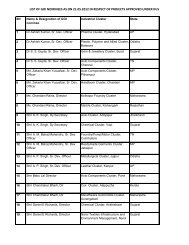fdi in india and its growth linkages - Department Of Industrial Policy ...
fdi in india and its growth linkages - Department Of Industrial Policy ...
fdi in india and its growth linkages - Department Of Industrial Policy ...
Create successful ePaper yourself
Turn your PDF publications into a flip-book with our unique Google optimized e-Paper software.
section <strong>in</strong>dustry data. However, the impact of FDI on the economy is still not clear <strong>and</strong> there is little evidence on the<br />
economy-wide impact of FDI <strong>in</strong> India. However, there is great <strong>in</strong>terest among academics <strong>and</strong> policy makers to critically<br />
exam<strong>in</strong>e the impact of FDI on the different sectors of the economy <strong>and</strong> various regions of the country.<br />
In India, FDI equity flows are concentrated <strong>in</strong> a few states (Morris, 2004). <strong>Of</strong> the total approved FDI flow, Maharashtra<br />
accounted for the largest proportion with 46 per cent, followed by Gujarat with 15 per cent, <strong>and</strong> Delhi with 7.7 per cent.<br />
Other states with significant <strong>and</strong> large <strong>in</strong>vestments were Andhra Pradesh, Karnataka <strong>and</strong> Tamil Nadu. Among these<br />
states, only a few cities were <strong>in</strong>volved <strong>in</strong> a significant amount of FDI. These <strong>in</strong>cluded Ahmedabad, Bangalore, Kolkata,<br />
Chennai, Coimbatore, Goa, Hyderabad, Jamnagar, Kancheepuram, Mumbai, Pune <strong>and</strong> Raigarh, <strong>in</strong>dicat<strong>in</strong>g that the<br />
geographical flow of FDI <strong>in</strong> India is skewed <strong>in</strong> favour of relatively large cities. However, for all <strong>in</strong>vestments, it is regions<br />
with metropolitan cities that have the advantage <strong>in</strong> headquarter<strong>in</strong>g the country operations of MNEs, thereby attract<strong>in</strong>g<br />
the bulk of FDI. The study suggests that there are vast ga<strong>in</strong>s to be made by attract<strong>in</strong>g FDI, especially <strong>in</strong> services <strong>and</strong><br />
high-tech skilled labour-seek<strong>in</strong>g <strong>in</strong>dustries.<br />
Aggarwal (2007) has shown that there are wide variations <strong>in</strong> the FDI <strong>in</strong>flow across the states of India. Only seven states 2<br />
accounted for over 97 per cent of the total amount of export-oriented FDI <strong>and</strong> 83 per cent of total FDI approvals dur<strong>in</strong>g<br />
1991-2001. The presence of Export Process<strong>in</strong>g Zones was found to be a relevant pull factor <strong>in</strong> attract<strong>in</strong>g export-oriented<br />
FDI. Further, while expla<strong>in</strong><strong>in</strong>g the sensitivity of FDI to labour market conditions, the study revealed that labour market<br />
rigidities <strong>and</strong> labour costs are more pronounced for export-oriented FDI than for domestic market-seek<strong>in</strong>g FDI.<br />
Infrastructure <strong>and</strong> regional development are found to be key factors <strong>in</strong> attract<strong>in</strong>g higher FDI, both <strong>in</strong> the export <strong>and</strong><br />
domestic market-seek<strong>in</strong>g sectors.<br />
FDI plant location is a complicated phenomenon. By utilis<strong>in</strong>g plant-level data across 100 of the largest cities <strong>in</strong> 17 states<br />
of India, Goldar (2007) established that the <strong>in</strong>ter-state <strong>and</strong> <strong>in</strong>ter-city distribution of plants of foreign firms is almost<br />
identical to that of domestic firms. This <strong>in</strong>dicates that the factors <strong>in</strong>fluenc<strong>in</strong>g the location of plants of foreign companies<br />
are, by <strong>and</strong> large, the same as those for domestic companies. But the number of plants of foreign companies <strong>in</strong> a city is<br />
positively related to the size of the city, civic amenities <strong>in</strong> the city, size of the largest city <strong>in</strong> the state <strong>and</strong> <strong>in</strong>vestment<br />
climate <strong>in</strong> the state. The presence of a metropolitan city <strong>in</strong> the state probably captures the advantage <strong>in</strong> headquarter<strong>in</strong>g<br />
the country operations of mult<strong>in</strong>ational companies.<br />
Exam<strong>in</strong><strong>in</strong>g <strong>in</strong>dustry-specific spill-over effects, Bergman (2006) has shown that pharmaceutical MNCs <strong>in</strong> India made a<br />
positive contribution to the <strong>growth</strong> <strong>and</strong> development of the <strong>in</strong>dustry. Spill-over effects through imitation, <strong>in</strong>dustrial<br />
management skills <strong>and</strong> competition were explicitly observed <strong>in</strong> the <strong>in</strong>dustry. Such effects were generated not only <strong>in</strong><br />
product development, but also <strong>in</strong> market<strong>in</strong>g <strong>and</strong> documentation techniques. The foreign firms’ presence has <strong>in</strong>directly<br />
encouraged domestic firms to <strong>in</strong>crease their managerial efforts <strong>and</strong> to adopt some of the market<strong>in</strong>g techniques used by<br />
MNCs. Further, the presence of foreign firms has <strong>in</strong>tensified competitive pressure <strong>in</strong> the <strong>in</strong>dustry <strong>and</strong> stimulated<br />
domestic firms to use accessible resources more efficiently. India’s comparative advantage <strong>in</strong> pharmaceuticals has boosted<br />
the Indian pharmaceutical enterprises to move <strong>and</strong> operate abroad.<br />
FDI benef<strong>its</strong> the host country <strong>in</strong> a number of ways. However, most of the studies conducted <strong>in</strong> India <strong>and</strong> abroad have<br />
been conf<strong>in</strong>ed to firm/<strong>in</strong>dustry-level analyses that focus on determ<strong>in</strong>ants <strong>and</strong> spill-overs from MNEs to domestic firms.<br />
In the Indian context, there is a perception that the flow of FDI, either through greenfield <strong>in</strong>vestment or mergers <strong>and</strong><br />
acquisitions, <strong>and</strong> their associated benef<strong>its</strong> are concentrated only <strong>in</strong> urban/metropolitan areas. It is thus important to<br />
know whether <strong>and</strong> by how much FDI has reached relatively small cities/ towns s<strong>in</strong>ce many of these are likely to have<br />
2. Andhra Pradesh, Tamil Nadu, Maharashtra, Gujarat, West Bengal, Uttar Pradesh <strong>and</strong> Kerala.<br />
INTRODUCTION<br />
3












